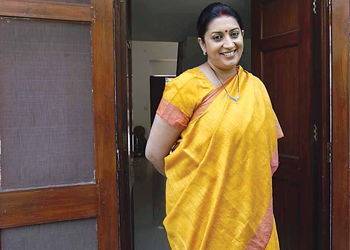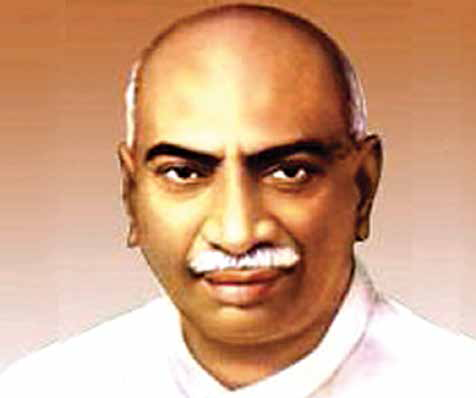Issue No.10 / June 16,2015

Rome, they say, was not built in a day. However, the media and citizens in our country think otherwise. The HRD ministry under the dynamic leadership of Union Minister Smriti Irani is a sterling example of how the new government is trying to transform the listless education sector, but we are not ready to give reasonable time for the same.
While the Narendra Modi government’s completing one year has triggered off a series of report cards on its performance, it is worth noting that as per the CAG report, the HRD ministry has already spent 80 percent of the allocated funds. Which means, things are moving and I would like to add, changing.
However, the HRD ministry is under the close and harsh scrutiny of the media, probably because Smriti Irani, who is a celebrity household name, thanks to her legendary performance in the super hit TV serial ‘kyunki saas bhi kabhi bahu this’ is at the helm of affairs. However, it would be worth noting the obvious that, at the outset, one individual does not make a decision; it is the government, which has layers of decision makers that involves academic experts, bureaucrats and political leaders, which does.

Ms. Irani, who also has been criticised for not being educated enough to handle such a ministry, has shown mettle, but people need to be patient to see results.
Traditionally, scholarly people with high degrees and PhDs used to be designated as ministers of HRD, never mind if they were Traditionally, scholarly people with high degrees and PhDs used to be designated as ministers of HRD, never mind if they were paper tigers. The problem is, no one can be qualified to call himself an authority on the various educational courses/specialisations. For example, a king need not know about every function of his kingdom. What matters is leadership, integrity, sincerity and the determination to follow policy guidelines given by the Prime Minister.
Traditionally, scholarly people with high degrees and PhDs used to be designated as ministers of HRD, never mind if they were paper tigers. The problem is, no one can be qualified to call himself an authority on the various educational courses/specialisations

Smriti Irani was also under fire for being vicariously responsible for the resignation of Dr. R K Shevgaonkar, IIT director who allegedly was being forced into parting with land for a celebrity cricketer’s sports academy and Dr. Anil Kakodkar, chairman of the board of governors of IIT-Bombay over differences with the HRD Ministry regarding the selection of IIT directors. Both have withdrawn their resignations and are working harmoniously towards strengthening the structure of premier engineering institutes. Similarly, a spate of secretary level bureaucrats moving away from her ministry also caught the eye of the media. Every organisation undergoes differences of opinion and patch-ups and hence to make a shrill noise about it seems silly and meaningless.
Smriti Irani, the youngest ever HRD minister at the age of 38, has had to bear the brunt of scathing attacks from the media and others, but thanks to her tenacious and confident nature, she remains unfazed

Also, all that the Director of IIT Madras, in his wisdom, did was, to direct the students to focus on their studies and stop unproductive activities.
Ms Irani has also gone public stating that she has saved 77,000 students who were pursuing Delhi University’s Four Year Undergraduate Programme (FYUP) of a degree that would render all of them unemployed. We need to believe in her conviction as the UGC too had opposed it.
Keep it up Smriti Irani. You remind me of the late K Kamaraj who had not completed even elementary school, and who hardly knew good English but was the Congress President, a successful Chief Minister and a kingmaker at a critical point of time
The list goes on and would continue for a woman who has had a meteoric rise and a Midas touch in everything she undertook. When she borrowed two lakh rupees from her father to get designer wear stitched from ace designer Manish Malhotra, to win the Miss India contest, she had to bite her lips, as she was a finalist, but not the winner. With her father’s loan (he ran a courier service), hanging like a Damocles sword, she did not find it demeaning to take up a job at McDonalds in Bandra where, besides being a waitress, she also cleaned floors and tables. Subsequently, she sold cosmetics in Delhi’s Janpath market until she was spotted by Ekta Kapoor, for the iconic role of Tulsi Virani. For a woman of such grit and perseverance, it is unlikely that she would fail in her present coveted role of a Union Minister in charge of the educational field that requires a vigorous shake up.
Here, I would like to mention my meeting with RSS supremo Mohan Bhagwatji before the recent Lok Sabha elections. The meeting took place one to one and he asked a lot of questions on the educational scenario of India. He subsequently called other leading educationists of Pune and held numerous deliberations. He was also travelling around the country, to feel the pulse of the existing pattern of education and he wanted to hear it from the horses’ mouths – one of them was luckily, me. I would presume that changes which are being done in the HRD ministry are a fallout of a comprehensive national survey undertaken by Bhagwatji and others. (I am not talking about the higher and technical education which is a matter before the Supreme Court on which even the HRD Ministry cannot take a stand at this moment.) To simply stamp any change as RSS driven saffronization would be unfair.
When you elect a new government, can’t it take a decision of its choice? If it can’t, then where is the democracy? After all, people have elected the government for a five year term. If you think it has proved to be regressive, you can throw it out after five years, but you cannot make a mountain out of a molehill each time some decision is taken. The opposition has every right to oppose, in fact it is its privilege, but it should play the role of a constructive opposition and the country’s interest should be kept in mind.
Unfortunately, there is little camaraderie for the right issues between politicians of rival parties. For example, former PM Manmohan Singh meeting the present PM Narendra Modi is an example of great statesmanship. It is a well-known fact that leaders share secrets which may not be recorded but are relevant. In states like Tamil Nadu, the animosity between two rival political parties is so intense, that a political party member is suspended if he or she happens to attend a social function of the rival party.
I would like to fervently appeal for restraint and patience by the media and co- operation by political opponents. For in this case, it is not about revenge, but it is about the academic progress of a whole future generation that is at stake.
It is relevant to mention here that reformation in India started when William Bentinck was the Governor General between1828 to 1831. It was he who started English education in India. Thanks to him India now has a national language which is the official language everywhere and we should be proud that Smriti Irani who may not be highly qualified academically, is heading the education and human resources development of the biggest populated democracy of the world. Watching her belt out poetic English and rhythmic Hindi, and quick and forceful rebuttals show us that it is only in a democracy can this happen.
She is the embodiment of women empowerment in India and we are proud of her. Keep it up Smriti Irani. You remind me of the late K Kamaraj who had not completed even elementary school, and who hardly knew good English but was the Congress President, a successful Chief Minister and a kingmaker at a critical point of time. People like me have seen many HRD ministers who were absolutely corrupt but nothing of that sort has been spoken about you so far. Keep it up. You have miles to go and lakhs of your followers will keep on praying for you.
Dr (Col.) A. Balasubramanian
editor-in-chief